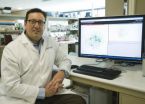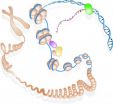(Press-News.org) Sleep disruptions may be among the earliest indicators of Alzheimer's disease, scientists at Washington University School of Medicine in St. Louis report Sept. 5 in Science Translational Medicine.
Working in a mouse model, the researchers found that when the first signs of Alzheimer's plaques appear in the brain, the normal sleep-wake cycle is significantly disrupted.
"If sleep abnormalities begin this early in the course of human Alzheimer's disease, those changes could provide us with an easily detectable sign of pathology," says senior author David M. Holtzman, MD, the Andrew B. and Gretchen P. Jones Professor and head of Washington University's Department of Neurology. "As we start to treat Alzheimer's patients before the onset of dementia, the presence or absence of sleep problems may be a rapid indicator of whether the new treatments are succeeding."
Holtzman's laboratory was among the first to link sleep problems and Alzheimer's through studies of sleep in mice genetically altered to develop Alzheimer's plaques as they age. In a study published in 2009, he showed that brain levels of a primary ingredient of the plaques naturally rise when healthy young mice are awake and drop after they go to sleep. Depriving the mice of sleep disrupted this cycle and accelerated the development of brain plaques.
A similar rising and falling of the plaque component, a protein called amyloid beta, was later detected in the cerebrospinal fluid of healthy humans studied by co-author Randall Bateman, MD, the Charles F. and Joanne Knight Distinguished Professor of Neurology at Washington University.
The new research, led by Jee Hoon Roh, MD, PhD, a neurologist and postdoctoral fellow in Holtzman's laboratory, shows that when the first indicators of brain plaques appear, the natural fluctuations in amyloid beta levels stop in both mice and humans.
"We suspect that the plaques are pulling in amyloid beta, removing it from the processes that would normally clear it from the brain," Holtzman says.
Mice are nocturnal animals and normally sleep for 40 minutes during every hour of daylight, but when Alzheimer's plaques began forming in their brains, their average sleep times dropped to 30 minutes per hour.
To confirm that amyloid beta was directly linked to the changes in sleep, researchers gave a vaccine against amyloid beta to a new group of mice with the same genetic modifications. As these mice grew older, they did not develop brain plaques. Their sleeping patterns remained normal and amyloid beta levels in the brain continued to rise and fall regularly.
Scientists now are evaluating whether sleep problems occur in patients who have markers of Alzheimer's disease, such as plaques in the brain, but have not yet developed memory or other cognitive problems.
"If these sleep problems exist, we don't yet know exactly what form they take—reduced sleep overall or trouble staying asleep or something else entirely," Holtzman says. "But we're working to find out."
### Roh JH, Huang Y, Bero AW, Kastne T, Stewart FR, Bateman RJ, Holtzman DM. Disruption of the sleep-wake cycle and diurnal fluctuation of amyloid-β in mice with Alzheimer's disease pathology. Science Translational Medicine, Sept. 5, 2012.
Washington University School of Medicine's 2,100 employed and volunteer faculty physicians also are the medical staff of Barnes-Jewish and St. Louis Children's hospitals. The School of Medicine is one of the leading medical research, teaching and patient care institutions in the nation, currently ranked sixth in the nation by U.S. News & World Report. Through its affiliations with Barnes-Jewish and St. Louis Children's hospitals, the School of Medicine is linked to BJC HealthCare.
Study in mice suggests sleep problems may be early sign of Alzheimer's
2012-09-06
ELSE PRESS RELEASES FROM THIS DATE:
Animal study finds anti-HIV vaginal ring can prevent virus transmission
2012-09-06
Population Council scientists have found that a vaginal ring releasing an anti-HIV drug can prevent the transmission of SHIV in macaques. This study provides the first efficacy data on the delivery of a microbicide from a vaginal ring, and indicates strong potential for the success of such rings in women. Microbicides are compounds that can be applied inside the vagina or rectum to protect against sexually transmitted infections (STIs), including HIV.
"This proof-of-concept study confirms that the investment in vaginal rings as a delivery system for HIV prevention is ...
Researchers unlock disease information hidden in genome's control circuitry
2012-09-06
Researchers at the University of Washington have determined that the majority of genetic changes associated with more than 400 common diseases and clinical traits affect the genome's regulatory circuitry. These are the regions of DNA that contain instructions dictating when and where genes are switched on or off. Most of these changes affect circuits that are active during early human development, when body tissues are most vulnerable.
By creating extensive blueprints of the control circuitry, the research also exposed previously hidden connections between different ...
Fast forward for biomedical research: ENCODE scraps the junk
2012-09-06
The hundreds of researchers working on the ENCODE project have revealed that much of what has been called 'junk DNA' in the human genome is actually a massive control panel with millions of switches regulating the activity of our genes. Without these switches, genes would not work – and mutations in these regions might lead to human disease. The new information delivered by ENCODE is so comprehensive and complex that it has given rise to a new publishing model in which electronic documents and datasets are interconnected.
Just as the Human Genome Project revolutionised ...
Albatross 'dynamic soaring' achieved by repeated curve-altitude oscillation
2012-09-06
Albatrosses leverage the energy of the wind to fly with essentially no mechanical cost to themselves, very rarely flapping their wings, and new work published Sep. 5 in the open access journal PLOS ONE offers insight into how exactly they accomplish this feat.
The researchers, led by Gottfried Sachs of the Technische Universitaet Muenchen and Francesco Bonadonna of the French National Centre for Scientific Research (CNRS), used advanced GPS tracking to determine that the energy gain during the albatross's "dynamic soaring" comes from a repeated oscillation consisting ...
Fathers who sleep closer to children have lower testosterone levels
2012-09-06
Closer sleeping proximity between fathers and children is associated with a greater decrease in the father's testosterone level, with possible implications for parenting behavior. The full report is published Sep. 5 in the open access journal PLOS ONE.
Fathers' testosterone levels have been associated with parenting behavior and involvement across species, with higher levels generally associated with lower parental involvement. The authors of the current study, led by Lee Gettler of the University of Notre Dame, studied 362 fathers in the Philippines to determine whether ...
Huge human gene study includes Penn State University research
2012-09-06
The first integrated understanding of how the human genome functions will be published this week -- the triumphant result of a collaborative five-year project involving more than 440 researchers working in 32 labs worldwide. The Encyclopedia of DNA Elements project, known as ENCODE, will publish simultaneously on 6 September 2012 a massive number of scientific papers, including 1 main integrative paper and 5 others in Nature; 18 in Genome Research; 6 in Genome Biology; and other affiliated papers in Science, Cell, and other scientific journals.
During the ENCODE study, ...
Yale team finds order amidst the chaos within the human genome
2012-09-06
Within the genome, sex does matter
Yale researchers studying the human genome say they can now tell how much "mom" and how much "dad" is genetically active in each of us.
These gender-specific markers may not determine which parent can take credit — or the blame — for the successes or shortcomings of their offspring; however, they could help explain differences in human populations.
"We can now track the relative genetic contribution of mom and dad," said Gerstein.
All human beings are born with two copies of the genome — one from the mother and one from the father. ...
Loss of tropical forests reduces rain
2012-09-06
Deforestation can have a significant effect on tropical rainfall, new research confirms. The findings have potentially devastating impacts for people living in and near the Amazon and Congo forests.
A team from the University of Leeds and the NERC Centre for Ecology & Hydrology found that for the majority of the Earth's tropical land surface, air passing over extensive forests produces at least twice as much rain as air passing over little vegetation. In some cases these forests increased rainfall thousands of kilometres away.
By combining observational data with predictions ...
Mapping a genetic world beyond genes
2012-09-06
Cambridge, MA. Wed. September 5, 2012 – Most of the DNA alterations that are tied to disease do not alter protein-coding genes, but rather the "switches" that control them. Characterizing these switches is one of many goals of the ENCODE project – a sweeping, international effort to create a compendium of all of the working parts of the human genome that have not been well studied or well understood.
The function of the vast majority of the human genome has remained largely unknown, but the Encyclopedia of DNA Elements (ENCODE) project, launched in 2003, set out to change ...
UMASS Medical School faculty annotate human genome for ENCODE project
2012-09-06
WORCESTER, MA — The first comprehensive decoding and annotation of the human genome is being published today by the ENCyclopedia Of DNA Elements (ENCODE) project, an international consortium of scientists from 32 institutions, including the University of Massachusetts Medical School. The groundbreaking ENCODE discovery appears in a set of 30 papers in Nature, Genome Research and Genome Biology.
Using data generated from 1,649 experiments – with prominent contributions from the labs of UMMS professors Job Dekker and Zhiping Weng – the group has assigned biochemical functions ...


